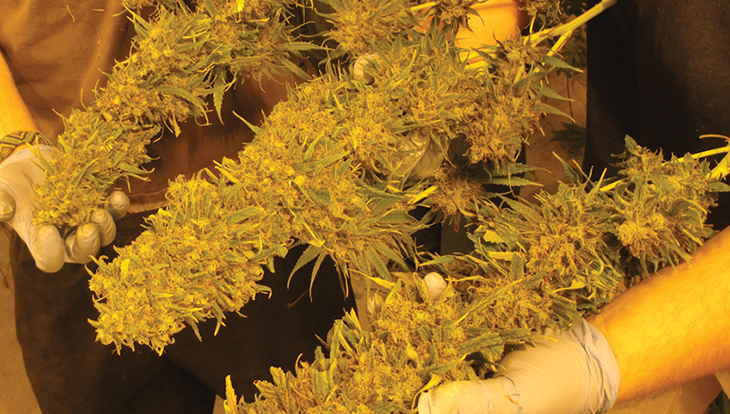- Continue Shopping
- Your Cart is Empty
N.Y. State Updates Medical Marijuana Program

New regulations propose adding chronic pain to qualifying conditions, allow wholesaling of MMJ.
New York’s Department of Health (NYSDOH) has relaxed its stringent regulations over the state’s medical marijuana program, allowing cannabis producers to wholesale their wares to other dispensaries and by adding chronic pain to the list of qualifying conditions.
The state government agency released a statement on Dec. 8 announcing the new changes.
“These are major steps forward for New York’s Medical Marijuana Program and the thousands of patients who are benefiting from it every day,” said Health Commissioner Dr. Howard A. Zucker in the release. “These enhancements will continue to strengthen the program and improve patient access by making medical marijuana available to patients suffering from chronic pain and making more products available at dispensing facilities across the state.”
The wholesaling rule changes, which take effect immediately, will allow the five licensed cultivators to sell their products to one another instead of forcing them to only sell in their own dispensaries. It also removes the “five brand” cap the program started with, meaning dispensaries will be able to offer more than five brands or products to their patients. This will make more varieties of products available at dispensaries across the state, according to the NYSDOH.
While the wholesaling changes take effect immediately, the addition of chronic pain to the list of qualifying conditions must wait in the wings as it must go through a 45-day comment period before it can be adopted. That comment period will begin Dec. 21, after the amendment is published on the state’s Register.
On top of allowing wholesaling and a plan to add chronic pain as a qualifying condition, the NYSDOH also allowed nurse practitioners to certify patients for the state’s medical marijuana program, increasing the number of health care professionals able to certify patients.
Sacramento Approves Cannabis Cultivation Ordinance

Sacramento is closer to becoming a regional hub for commercial marijuana production, but significant hurdles remain before the city flowers with industrial pot gardens.
City Council members voted 5-3 Tuesday to allow licensed cultivation within city limits. But it will be months before permits are issued and the city still must establish fees for grower licenses.
The city also needs to flesh out its proposed “neighborhood responsibility plan,” in which cultivators would pay fees to cover services that benefit surrounding neighborhoods. Two council members, Allen Warren and Eric Guerra, lobbied for that program because they are concerned how cultivation will affect their districts, each with concentrations of warehouses suitable for growing.
“We had a lot of cultivators say they do want to be good neighbors and contribute to the overall wealth of the community, and we want to take advantage of that,” said Councilman Jay Schenirer, who crafted the cultivation ordinance, arguing it was a necessary step to ensure the city properly regulated the marijuana industry while protecting communities.
Such fee amounts will be based on an upcoming study examining the effects of pot operations on policing demands, property values and quality of life, among other factors.
California Votes Yes on Prop 64

The Golden State is expected to become the new cannabis cultivation mecca
California will be adding to its already bountiful coffers after residents passed Prop 64, legalizing recreational marijuana in the Golden State.
Voters left no doubt as to their will, passing the measure by over a million votes and with a 12-point spread of 56-44 in favor of Prop 64.
California is expected to be the biggest cannabis market in North America once the program is fully operational, and the state will be one of the big winners. A new report released Nov. 7 by state fiscal experts at Blue Sky Consulting Group projects that Proposition 64, the Adult Use of Marijuana Act, will generate almost $1 billion in new, increased state and local revenue annually when fully implemented. The measure imposes a 15 percent marijuana excise tax on all marijuana sales
"This is the most important moment in the history of the marijuana legalization movement,” says Tom Angell, Chairman of Marijuana Majority, a national pro-cannabis organization. “California is the sixth-largest economy in the world and is hugely culturally influential. Most importantly, this vote will dramatically accelerate the end of federal marijuana prohibition.”
The Adult Use of Marijuana Act is one of the most extensive pieces of cannabis legalization seen in the U.S., according to California Lieutenant Governor Gavin Newsom. Newsom called the measure “the most thoughtful marijuana policy in the nation – with the strictest child protections and billions in new revenue for important programs such as public safety,” when he endorsed the ballot measure in July.
Beyond child protection regulations and public safety spending, the new law also puts forward several rules when it comes to cultivation and sets the Department of Food and Agriculture as the regulatory authority.
“The medical and recreational systems each face significant implementation challenges that will only be heightened due to the enormous size of [the] illicit and unlicensed marijuana market presently in existence in California,” says Aaron Herzberg, Partner and General Counsel at CalCann Holdings, a cannabis property management firm. “It will be difficult for the industry to make the death-defying jump from the state’s mammothly [sic] unregulated medical pot economy to a regulated adult-use system unless these illegal and unlicensed businesses, many of which skirt the law, are put out of business.”
Part of these new changes is a new set of license types is also created, which is broken down by type of grow and size. Of the 19 new license types, from cultivation licenses to third-party testing licenses, cultivators will get to choose between 13. They range from indoor, outdoor, to greenhouse licenses (called “mixed-light”), and from small and medium (which are the same size as their medical cannabis equivalents) and a new “large” license designation. Indoor and greenhouse growers utilizing over 22,000 square feet of canopy will need to apply for the large license type, with the same applying to outdoor cultivators using more than one acre to grow recreational cannabis.
No details as to the number of licenses were specified in the measure.
Recreational cannabis license applicants also will be required to submit a plan of their standard operation procedures (SOPs), including those for cultivation and quality control, starting Jan. 1, 2018 (when the licensing authority will begin accepting applications.)
New standards have now been set that are intended to bring the grey market into the light: new environmental standards and regulations, including proving cultivators are drawing water from a legal source and disposing of runoff properly; comprehensive laboratory testing, from cannabinoid and terpene profiling to pesticide and mold testing; and state authorities will be allowed to inspect any licensed business without warning to ensure compliance.
“Not only are tens of thousands of jobs going to be created, but cannabis will be regulated in a system built to keep consumers safe from pesticides and other additives,” says Flowhub CEO Kyle Sherman. “When a regulatory system is put into place it protects society as well, removing criminal enterprise from the equation. Tax dollars are going to flow into the state instead of the black market.”
But not everyone is celebrating today. In fact, several cannabis cultivators came out against the Adult Use of Marijuana Act, including the Humboldt Growers Collective, prior to it becoming law.
Steve Dodge, CEO of the Humboldt Growers Collective, said, “Prop 64 smacks of collusion with big money and big corporations” in an Oct. 30 blog post on the group’s website. He and other opponents in the industry are afraid Prop 64 doesn’t offer any long-term protections to smaller growers and they will see the cannabis industry taken over by larger companies and goliaths such as Monsanto.
![]()








